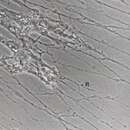ar
الأسماء في صفحات التنقل


The name Reticulomyxidae was first proposed by Page (1987: 209) for a new family within the Order Promycetozoida (Phylum Rhizopoda: Class Granuloreticulosea). The type genus of Reticulomyxidae is Reticulomyxa.
As originally defined by Page (1987), members of the Family Reticulomyxidae possess the following combination of traits: “naked, multinucleate plasmodia, highly reticulate, usually without distinct polarity.” Page (1987) included the following genera in Reticulomyxidae: Reticulomyxa, Pontomyxa, and Thalassomyxa. As mentioned below, Reticulomyxa is now known to be a foraminiferan. The phylogenetic relationships of Pontomyxa are currently unknown; however, the genus is classified within Rhizaria as Incertae Sedis (Adl et al. 2012). Thalassomyxa is currently classified in Vampyrellida, which would make it more closely related to Plamosdiophorida than to Foraminifera (Adl et al. 2012, Hess et al. 2012), making the Reticulomyxidae as originally formulated by Page (1987) a polyphyletic taxon.
Lee et al. (2000) removed the Family Reticulomyxidae from the Order Promycetozoida, and placed it in the Class Athalamea (Phylum Granuloreticulosea). The Reticulomyxidae as emended by (Lee et al. 2000) is a monotypic taxon that contains only a single genus and species, Reticulomyxa filosa.
Recent molecular systematic studies have shown the name-bearing type of the Reticulomyxidae, Reticulomyxa filosa, to be a foraminiferan (Pawlowski et al. 1999a, Pawlowski et al. 1999b), thus the Reticulomyxidae as emended by (Lee et al. 2000) would be classified as subordinate to the Foraminifera in a rank-based nomenclatural system.
Family Reticulomyxidae PAGE, 1987, emend. HÜLSMANN, 2014
Large plasmodia with hundreds or thousands of small nuclei involved in bidirectional streaming. Obligatory alternation of sessile and motile stages. Locomotion by migration via one or several giant pseudopodia with pre-dominantly unidirectional centrifugal streaming of protoplasm. Cyst formation. Tectum as (protective) covering. Occasional formation of protoplasmic propagules (blisters, blebs) from pseudopodia and central areas. Omnivorous or predatory. Occurring in freshwater habitats. Four described species. Type genus: Reticulomyxa Nauss, 1949. The family also includes the the genera Wobo Hülsmann, 1986, 2006, Haplomyxa Dellinger, 2014 and Dracomyxa Hülsmann, 2014.
Reticulomyxidae is een familie in de taxonomische indeling van de Amoebozoa. Deze micro-organismen hebben geen vaste vorm en hebben schijnvoetjes. Met deze schijnvoetjes kunnen ze voortbewegen en zich voeden.[1]
Bronnen, noten en/of referenties